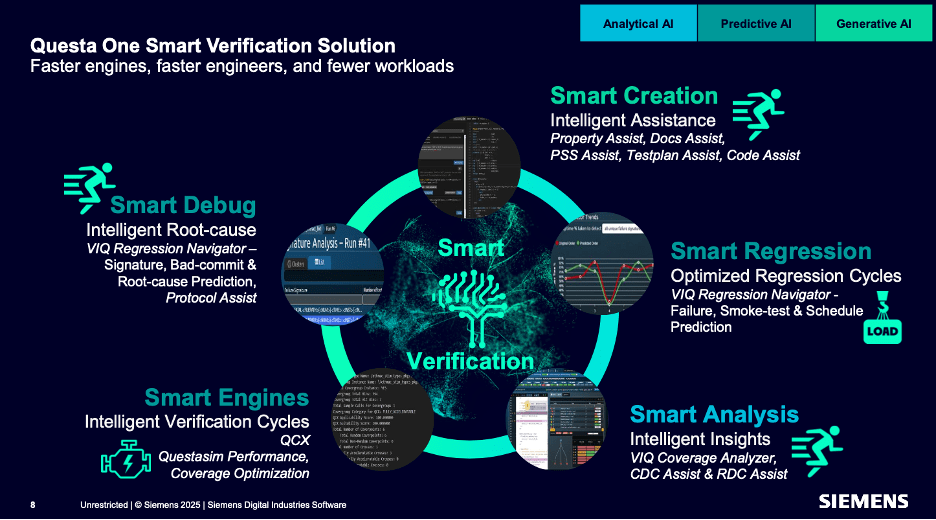I wrote recently about a Siemens pre-announcement at DVCon on their directions in simulation+AI. On May 13th they officially announced a full spectrum of capabilities under the brand Questa One. Abhi Kolpekwar (VP/GM at Siemens EDA) more fully fleshed out the story for me. I asked why Siemens is late to this simulation+AI party. In fairness their first product in this space, Verification IQ, appeared in 2023. For the more complete story he says they have been very conservative, aiming not just to be fully ready but also to build a string of high-profile endorsements. I get it; customers want supplier options in simulation and three options is better than two. If those customers see Questa One measuring up then it is reasonable to assume that Siemens, if late to the party, is surely now making an entrance.

The complete story
Abhi stressed that Questa has undergone an extensive rewrite, first for significant upgrades in performance, and second to unify functional, fault, RTL, gate-level simulation, coverage, acceleration, parallel processing and design/simulation profiling, all through a single install, common user interface and debug. Hence the name – Questa One. This is complemented by Questa One SFV (stimulus free verification, essentially a merge of static and formal methods), Questa One Verification IQ linking Questa One to the earlier released Verification IQ, and Questa One Avery VIP for VIPs and testbench automation.
I’m primarily interested in AI applications through the suite. GenAI plays a role in Property Assist, a method to autogenerate assertions from natural language prompts (I saw a demo of this), Docs assist which I remember from DVCon is intended to autogenerate docs based on current design collateral (perhaps a feature unique to this platform?). We didn’t talk about PSS Assist, Testplan Assist or Code Assist but I can guess that these features help respectively with generating PSS scenarios, mapping from a natural language testplan to executable tests, and RTL code snippet generation (similar intent to CoPilot).
Smart Regression capabilities in ViQ provide the intelligent control of regression ordering and resource utilization we would expect. This will accelerate likely failures in testing, optimize use of the compute grid, and provide regression schedule insight.
Questa One ViQ provides many of the AI-based capabilities in this release. This includes analysis to predict patterns and holes in coverage, provide root cause analysis and suggest solutions. ViQ seems to be well established. For debug, they have early adopter engagements in bad commit prediction, root cause prediction and signature prediction. And in regression navigation they have early adopters in smoke test prediction.
QCX (coverage acceleration) is a capability I would like to understand better. This is listed under predictive AI and appear to be about regression optimization, that is removing tests from the suite when they contribute little to increasing coverage. This is a hot topic and certainly should have a major impact on time to coverage closure. Siemens claim they have seen cases up to 50X faster than for unoptimized suites.
Smart Debug is another hot area and more challenging than it might appear. There is no silver bullet I know of, but rather a collection of methods to attempt to isolate a root cause. Questa One here looks for correlation of failures with immediately preceding commits or design changes and creating failure signatures around similar or repetitive issues. This is a good area for use of AI methods against regression history (using the ViQ regression navigator). Siemens also mentions here a Protocol Assist to track down protocol errors, perhaps based on the Questa One Avery capabilities.
Smart Analysis leverages unsupervised learning to identify coverage holes, present cross-hole analysis to highlight potential weaknesses in the testplan, also to identify pattern correlations against the RTL.
Endorsements and availability
Siemens EDA have gathered a top tier set of endorsements for this product. As Abhi mentioned, they have been running largely in silent mode until they had these in place. Among those they can share so far are the following:
Karima Dridi, Head of Productivity Engineering, Arm says: “As an early adopter of running large EDA workloads using the high-performance Questa One Sim advanced functional simulator, we’ve observed improvements in performance, cost-efficiency, and reduction in regression time on the latest AArch64 architecture.”
Chienlin Huang, senior technical manager of Connectivity Technology Department, MediaTek, notes: “Questa One Property Assist utilizes generative AI to save us weeks of engineering time, and Questa One Regression Navigator predicts which simulation tests are most likely to fail, runs them first, and saves days of regression and debugging time.”
Susheel Tadikonda, vice president of Engineering, Silicon IP at Rambus, adds: “Siemens’ Questa One smart verification solution has improved and streamlined our verification process, enabling us to address new-era data center workloads like generative AI with state-of-the-art silicon IP solutions for PCIe, CXL and HBM interfaces. Leveraging the complete Questa One solution, including simulation, static and formal analysis, and verification IP technologies, brings increased confidence to our customers through comprehensive verification of IP solutions for their SoC and chiplet designs.”
And from Microsoft: “Questa One DFT (QDX) simulation utilizes advanced DFT-centric simulation capabilities to deliver faster performance than existing simulation solutions, slashing our verification time from weeks to days,” said Selim Bilgin, corporate vice president, Silicon Engineering at Microsoft. “In addition to these impressive speed ups, on Microsoft’s Azure Cobalt 100 platform QDX delivers up to 20 percent further performance jump unlocking even greater efficiency for our EDA workloads.”
Altogether, Siemens now looks more interesting in this space. The Questa One smart verification solution will be available in June 2025. You can learn more HERE.
Also Read:
Siemens EDA Outlines Strategic Direction for an AI-Powered, Software-Defined, Silicon-Enabled Future
EDA AI agents will come in three waves and usher us into the next era of electronic design
Safeguard power domain compatibility by finding missing level shifters
Share this post via:





Comments
There are no comments yet.
You must register or log in to view/post comments.